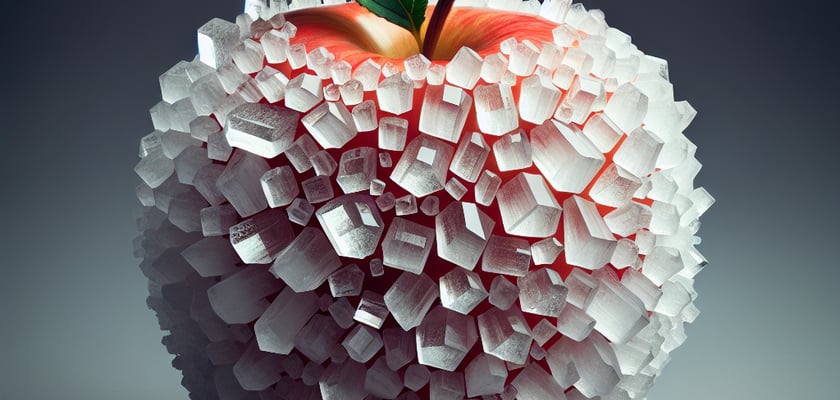Have you ever wondered what happens when Snow White’s apple meets a science experiment? Enter the salt crystal apple, the unsung hero of kitchen chemistry and decorative fruit bowls. This wondrous collision of cuisine and craft is more than just a pretty centerpiece; it’s the lovechild of evaporation and saturation—kind of like the fairy tale marriage of sugar, water, and a touch of “let’s leave it and see what happens.” No ordinary apple can claim to be part experiment, part art piece, and 100% Instagrammable. With their sparkling crystal cloaks, these apples can seduce the eye, tickle the fancy, and make you think twice about biting into them—lest you chip a tooth on their crunchy crystal exteriors.
But wait, don’t dash off to your kitchen laboratory just yet! There’s more to these geological gems than meets the taste buds. What about their ability to teach patience and the thrilling anticipation of watching crystals grow—akin to waiting for your favorite series to drop a new season, but with more science and less couch time? In the upcoming section, we’ve got the juicy details on how these crystallized pommes transform from ordinary fruit to rock candy sculptures. We will peel back the layers of this fascinating process, exploring the step-by-step ritual that leads to their creation and the reasons why your kitchen suddenly feels like a mini geode farm. Don’t go anywhere; the core insights are just ahead, and we promise they won’t be sour.
Key points I covered in this post
1. “Salt crystal apples” refers to a visual phenomenon where apples, due to certain conditions, become coated in a layer of salt crystals. This occurs when the fruit’s own moisture draws out salt from a saline environment, leading to the formation of intricate and delicate salt structures on the apple’s surface.
2. The process of creating salt crystal apples requires specific environmental conditions, including high salinity, humidity, and temperature. These factors work together to facilitate the evaporation of water from the fruit, leaving behind salt crystals that adhere to the apple’s skin.
3. Salt crystal apples are not only aesthetically captivating with their unique, frost-like appearance, but they also serve as an example of the complex interactions between fruit, salt, and their surroundings. This natural process is similar to the crystallization procedures used in culinary and scientific practices.
4. While salt crystal apples are not typically considered edible due to the excessive salt content, they have gained attention as a subject of artistic and scientific intrigue. Photographers, artists, and educators often use these crystallized fruits to explore themes of transformation, preservation, and the beauty of natural processes.
5. Interest in salt crystal apples has also sparked curiosity in potential applications beyond the visual. For example, researchers may study the preservative effects of salt crystallization on fruit or the potential for using similar methods to create food decorations or enhancements for culinary presentation.
What Are Salt Crystal Apples?
In essence, salt crystal apples are a unique combination of science and culinary art that demonstrate the process of crystallization. They are apples coated in a salt solution that is left to evaporate, resulting in a layer of salt crystals forming on the fruit’s surface. This ingenious blend of flavor and texture offers a distinct taste experience, adding a crunchy, salty dimension to the naturally sweet fruit.
The Science Behind the Crystallization Process
Salt crystal formation on apples is a result of the crystallization process, where a supersaturated solution of salt and water begins to crystallize as the water slowly evaporates. The ideal conditions for this include warm temperature and relatively low humidity, encouraging the water to evaporate and leave behind the salt’s geometric crystal lattice. To achieve a more consistent crystal formation, the apples are often rotated periodically during the evaporation phase to ensure even coverage and optimal aesthetic appeal.
Selecting the Perfect Apples for Salt Crystallization
Choice of apple variety is crucial when creating salt crystal apples. Varieties with a firmer flesh, such as Granny Smith or Honeycrisp, are typically preferred because they can withstand the weight of the salt crystals without losing their shape. Moreover, apples should be fresh and free from blemishes to ensure a smooth crystallization process and an attractive final product.
Preparing the Salt Solution for Crystallization
The type of salt used can significantly influence the size, shape, and clarity of the crystals formed. Using non-iodized salt, such as kosher salt or sea salt, is recommended due to the absence of anti-caking agents, which can interfere with crystal formation. Creating the perfect supersaturated solution involves slowly adding salt to boiling water until no more can be dissolved, indicating the saturation point has been reached.
Detailing the Salt Crystallization Process
After preparing the apples – which involves washing, thoroughly drying, and sometimes skewering for easier handling – they are dipped into the hot supersaturated salt solution. Following the initial dip, the apples are left to dry in a controlled environment, where the salt crystals will start to form as the water evaporates. Regular monitoring is required to adjust environmental conditions and avoid any disruptions in the crystal formation.
Unique Flavor and Textural Elements
The presence of salt crystals introduces a distinguishable crunch and robust flavor, adding depth to the apple’s natural sweetness. This combination creates a complex sensory experience. The salt can also draw out additional flavors and aromas from the apple, potentially enhancing its inherent qualities and making for a truly gourmet experience.
Preserving the Salt Crystal Apples for Longevity
To preserve the structural integrity and aesthetic of salt crystal apples following the crystallization process, it’s essential to store them in the right environment. They should be kept at a stable temperature, away from direct sunlight and high humidity, which could cause the crystals to dissolve or the apples to degrade faster. Wrapping them in a dry, breathable material could help maintain their condition for an extended period.
Potential Uses and Presentation Ideas
The striking look and unique flavor profile of salt crystal apples allow for a variety of creative culinary uses, ranging from decorative centerpieces to novel dessert components. They can be used whole or sliced, possibly alongside other sweet or savory dishes that can benefit from a salty contrast. Professional chefs and amateurs alike can experiment with presentation, employing these crystallized apples as a tool to elevate the dining experience.
Are There Any Tips for Creating Perfect Salt Crystal Apples?
- Select high-quality, firm apples to ensure they can support the weight of the salt crystals.
- Use non-iodized salt for the solution to achieve clearer and more visually appealing crystals.
- Maintain a controlled environment during the evaporation process to avoid humidity affecting the crystal formation.
- Rotate the apples occasionally during drying to promote uniform crystal growth.
- Store the finished salt crystal apples properly to preserve their beauty and structure.
- Experiment with different varieties of apples and salts to create unique flavors and textural contrasts.
Are salt crystal apples safe to eat?
While salt crystal apples are primarily an educational or decorative experiment and not intended for consumption, the presence of salt crystals themselves isn’t harmful if ingested in small quantities. However, consuming large amounts of salt can be unhealthy, and the crystals may also collect impurities during their formation, so it’s not recommended to eat the apples used in this experiment.
How long does it take for crystals to form on the apple?
The time it takes for salt crystals to form on an apple can vary depending on several factors such as the concentration of the salt solution and the environmental conditions. Typically, crystal growth can be observed within a few hours, but allowing the apple to sit in the solution for a few days to a week can result in more substantial crystal growth.
What type of salt is best for growing crystals on apples?
For growing salt crystals on apples, table salt (sodium chloride) is the most commonly used due to its availability and solubility. However, you can experiment with different types of salts like Epsom salt (magnesium sulfate) or sea salt for varying crystal textures and shapes.
Can I color the salt crystals on the apple?
Yes, you can color the salt crystals by adding food coloring to the salt solution. This will give the crystals a colorful appearance as they form and adhere to the surface of the apple, making for a more visually appealing experiment.
What is the scientific principle behind the formation of salt crystals on apples?
The formation of salt crystals on apples is based on the principles of saturation and evaporation. When salt is dissolved in water, it creates a solution. If the solution becomes supersaturated, meaning it contains more salt than the water can hold, salt crystals will begin to form. As the water evaporates, less and less is available to hold the dissolved salt, causing the salt to precipitate out of the solution and form crystals on the surface of the apple.
Final Thoughts
The process of growing salt crystals on apples offers a fascinating glimpse into the world of crystallography and solubility. It’s a simple yet powerful demonstration of how substances transition from one state to another, and it can be an entertaining way to teach these scientific concepts. Whether for educational purposes or just for fun, creating salt crystal apples can spark curiosity and wonder in observers of all ages. The beauty of the crystals, coupled with the accessibility of the materials required, makes it an experiment that’s easy to try at home or in the classroom.
Moreover, delving into such experiments promotes understanding of the natural processes that lead to the formation of minerals in nature. Observing the intricate patterns and geometric formations gives us an appreciation for the complexities of the physical world. In conclusion, salt crystal apples not only provide a visually engaging experience but also open the door for deeper inquiry into the wonders of science.

